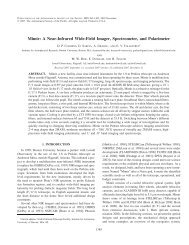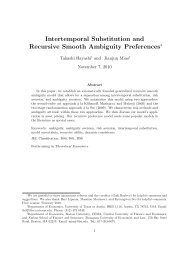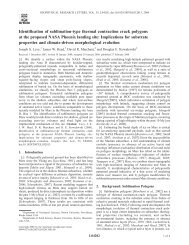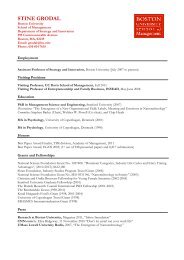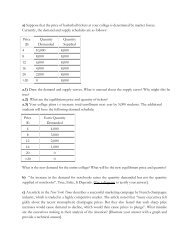Ineffable tenses in Benue-Kwa and Romance - people on the Web ...
Ineffable tenses in Benue-Kwa and Romance - people on the Web ...
Ineffable tenses in Benue-Kwa and Romance - people on the Web ...
- No tags were found...
You also want an ePaper? Increase the reach of your titles
YUMPU automatically turns print PDFs into web optimized ePapers that Google loves.
<str<strong>on</strong>g>Ineffable</str<strong>on</strong>g> <str<strong>on</strong>g>tenses</str<strong>on</strong>g> <str<strong>on</strong>g>in</str<strong>on</strong>g> <str<strong>on</strong>g>Benue</str<strong>on</strong>g>-<str<strong>on</strong>g>Kwa</str<strong>on</strong>g> <str<strong>on</strong>g>and</str<strong>on</strong>g> <str<strong>on</strong>g>Romance</str<strong>on</strong>g><br />
Victor Manfredi, Bost<strong>on</strong> University<br />
12 September 2012<br />
ABSTRACT Some natural languages can’t dist<str<strong>on</strong>g>in</str<strong>on</strong>g>guish past from present perfect without recourse to periphrasis or c<strong>on</strong>text. This expressive<br />
gap is unexpected if <str<strong>on</strong>g>tenses</str<strong>on</strong>g> are aut<strong>on</strong>omous mean<str<strong>on</strong>g>in</str<strong>on</strong>g>g postulates (Reichenbach 1947, Hornste<str<strong>on</strong>g>in</str<strong>on</strong>g> 1990, Giorgi & Pianesi 1997), but is grist<br />
for <strong>the</strong>ories where tense <str<strong>on</strong>g>in</str<strong>on</strong>g>terpretati<strong>on</strong>s emerge from syntax-pragmatics <str<strong>on</strong>g>in</str<strong>on</strong>g>teracti<strong>on</strong> <str<strong>on</strong>g>in</str<strong>on</strong>g>directly (McCawley 1971, Vikner 1985, Enç 1987).<br />
English has an unambiguous present perfect (*I have danced yesterday, Kle<str<strong>on</strong>g>in</str<strong>on</strong>g> 1992) but French doesn’t (J’ai dancé hier tak<str<strong>on</strong>g>in</str<strong>on</strong>g>g over Je dansai hier),<br />
<str<strong>on</strong>g>and</str<strong>on</strong>g> <strong>the</strong> atrophy of <strong>the</strong> simple preterite <str<strong>on</strong>g>in</str<strong>on</strong>g> nor<strong>the</strong>rn <str<strong>on</strong>g>Romance</str<strong>on</strong>g> co<str<strong>on</strong>g>in</str<strong>on</strong>g>cides with several o<strong>the</strong>r developments related to case, agreement <str<strong>on</strong>g>and</str<strong>on</strong>g><br />
aspect (Zamb<strong>on</strong>i 2000, 87 cited by Ledgeway 2012, 314). In <strong>the</strong> <str<strong>on</strong>g>Benue</str<strong>on</strong>g>‐<str<strong>on</strong>g>Kwa</str<strong>on</strong>g> (BK) subgroup of Niger‐C<strong>on</strong>go, an unambiguous present<br />
perfect occurs <str<strong>on</strong>g>in</str<strong>on</strong>g> most of <strong>the</strong> major clusters, <str<strong>on</strong>g>in</str<strong>on</strong>g>clud<str<strong>on</strong>g>in</str<strong>on</strong>g>g Àkan, Ẹ̀dó, Ìgbo, Cross, Plateau <str<strong>on</strong>g>and</str<strong>on</strong>g> Bantoid, but does not exist <str<strong>on</strong>g>in</str<strong>on</strong>g> a substantial,<br />
c<strong>on</strong>tiguous subset—call it BK2—compris<str<strong>on</strong>g>in</str<strong>on</strong>g>g Gbè, Yorùbá, Nupe <str<strong>on</strong>g>and</str<strong>on</strong>g> Ìdọmà, where any f<str<strong>on</strong>g>in</str<strong>on</strong>g>ite affirmative episodic predicate <str<strong>on</strong>g>in</str<strong>on</strong>g> pr<str<strong>on</strong>g>in</str<strong>on</strong>g>ciple<br />
allows ei<strong>the</strong>r present perfect or simple past c<strong>on</strong>strual. This bifurcati<strong>on</strong> of BK arguably followed <strong>on</strong> <strong>the</strong> erosi<strong>on</strong>al loss of f<str<strong>on</strong>g>in</str<strong>on</strong>g>ite affixati<strong>on</strong> <str<strong>on</strong>g>in</str<strong>on</strong>g><br />
BK2, <str<strong>on</strong>g>and</str<strong>on</strong>g> <str<strong>on</strong>g>in</str<strong>on</strong>g>troduced o<strong>the</strong>r correlated changes of a quantal nature <str<strong>on</strong>g>in</str<strong>on</strong>g> its wake (Manfredi 2005a, 2009). One reas<strong>on</strong> UG doesn’t need to<br />
stipulate a tense system is that time reference is partly redundant with default <str<strong>on</strong>g>in</str<strong>on</strong>g>terpretati<strong>on</strong> of lexical Akti<strong>on</strong>sart (Green & Ígwè 1963, 53;<br />
Welmers & Welmers 1968, 76; Dowty 1986, Décha<str<strong>on</strong>g>in</str<strong>on</strong>g>e 1991, Sorace 2000). But <strong>the</strong> crossl<str<strong>on</strong>g>in</str<strong>on</strong>g>guistic parallelism is <str<strong>on</strong>g>in</str<strong>on</strong>g>complete: <str<strong>on</strong>g>in</str<strong>on</strong>g> sou<strong>the</strong>rn<br />
<str<strong>on</strong>g>Romance</str<strong>on</strong>g>, present perfect morphology automatically codes for recent past, but <str<strong>on</strong>g>in</str<strong>on</strong>g> BK1 <strong>the</strong>se two traits are orthog<strong>on</strong>al (Welmers 1973).<br />
1. <str<strong>on</strong>g>Benue</str<strong>on</strong>g>-<str<strong>on</strong>g>Kwa</str<strong>on</strong>g><br />
Crossl<str<strong>on</strong>g>in</str<strong>on</strong>g>guistic variati<strong>on</strong> am<strong>on</strong>g tense c<strong>on</strong>structi<strong>on</strong>s is widely observed <str<strong>on</strong>g>in</str<strong>on</strong>g> Niger-C<strong>on</strong>go, e.g. <str<strong>on</strong>g>in</str<strong>on</strong>g> <strong>the</strong> <str<strong>on</strong>g>Benue</str<strong>on</strong>g>-<str<strong>on</strong>g>Kwa</str<strong>on</strong>g> (BK) group. 1<br />
Welmers (1973, 343-50) discusses two apparently orthog<strong>on</strong>al differences: general past/completive <str<strong>on</strong>g>and</str<strong>on</strong>g> recent/remote:<br />
For <strong>the</strong> most part, <strong>the</strong> verbal systems of Niger-C<strong>on</strong>go languages are best described <str<strong>on</strong>g>in</str<strong>on</strong>g> terms of a unidimensi<strong>on</strong>al list of<br />
“verbal c<strong>on</strong>structi<strong>on</strong>s” ra<strong>the</strong>r than <str<strong>on</strong>g>in</str<strong>on</strong>g> terms of a bidimensi<strong>on</strong>al or multidimensi<strong>on</strong>al grid with <str<strong>on</strong>g>in</str<strong>on</strong>g>tersect<str<strong>on</strong>g>in</str<strong>on</strong>g>g categories such<br />
as tense, aspect <str<strong>on</strong>g>and</str<strong>on</strong>g> mode [sc. mood]. There may be ways of express<str<strong>on</strong>g>in</str<strong>on</strong>g>g twodimensi<strong>on</strong>al parallelisms such as <strong>the</strong> simple<br />
vs. progressive acti<strong>on</strong> <str<strong>on</strong>g>in</str<strong>on</strong>g> <strong>the</strong> past <str<strong>on</strong>g>and</str<strong>on</strong>g> <str<strong>on</strong>g>in</str<strong>on</strong>g> <strong>the</strong> future (as ‘he worked, he was work<str<strong>on</strong>g>in</str<strong>on</strong>g>g; he will work, he will be work<str<strong>on</strong>g>in</str<strong>on</strong>g>g’), but<br />
(as <str<strong>on</strong>g>in</str<strong>on</strong>g> Englsh also) <strong>the</strong>se dist<str<strong>on</strong>g>in</str<strong>on</strong>g>cti<strong>on</strong>s typically do not <str<strong>on</strong>g>in</str<strong>on</strong>g>volve comb<str<strong>on</strong>g>in</str<strong>on</strong>g>ati<strong>on</strong>s of morphemes as a verbal form, but ra<strong>the</strong>r<br />
auxiliaries <str<strong>on</strong>g>and</str<strong>on</strong>g> similar sec<strong>on</strong>dary c<strong>on</strong>structi<strong>on</strong>s. Even <strong>the</strong> affirmative-negative c<strong>on</strong>trast is usually asymmetrical; <strong>the</strong>re are<br />
typically more affirmative than negative c<strong>on</strong>structi<strong>on</strong>s, <str<strong>on</strong>g>and</str<strong>on</strong>g> not all negatives are formed <str<strong>on</strong>g>in</str<strong>on</strong>g> <strong>the</strong> same way or <str<strong>on</strong>g>in</str<strong>on</strong>g> terms of a<br />
s<str<strong>on</strong>g>in</str<strong>on</strong>g>gle simple transformati<strong>on</strong> applied to affirmatives. In <strong>the</strong> Bantu languages, <strong>the</strong> unidimensi<strong>on</strong>al character of <strong>the</strong> system is<br />
so c<strong>on</strong>spicuous that many grammarians, hav<str<strong>on</strong>g>in</str<strong>on</strong>g>g applied <strong>the</strong> term “tense” to forms with obvious reference to past, present<br />
<str<strong>on</strong>g>and</str<strong>on</strong>g> future time, have felt compelled to extend that label to o<strong>the</strong>r forms with similar morphological compositi<strong>on</strong>, so that<br />
<strong>on</strong>e hears such <str<strong>on</strong>g>in</str<strong>on</strong>g>c<strong>on</strong>gruous comb<str<strong>on</strong>g>in</str<strong>on</strong>g>ati<strong>on</strong>s as “<strong>the</strong> subjunctive tense” <str<strong>on</strong>g>and</str<strong>on</strong>g> “<strong>the</strong> c<strong>on</strong>diti<strong>on</strong>al tense”.<br />
In many languages <strong>the</strong>re is a s<str<strong>on</strong>g>in</str<strong>on</strong>g>gle c<strong>on</strong>structi<strong>on</strong> which has explicit <str<strong>on</strong>g>and</str<strong>on</strong>g> exclusive reference to past acti<strong>on</strong>; for such<br />
languages it is quite legitimate to speak of a “past” c<strong>on</strong>structi<strong>on</strong>. It has already been noted, however, that some languages<br />
use a s<str<strong>on</strong>g>in</str<strong>on</strong>g>gle c<strong>on</strong>structi<strong>on</strong> to refer to past time for active verbs <str<strong>on</strong>g>and</str<strong>on</strong>g> present time for stative verbs […] Some Bantu<br />
languages dist<str<strong>on</strong>g>in</str<strong>on</strong>g>guish a “near past” (particularly with reference to acti<strong>on</strong> performed earlier <strong>on</strong> <strong>the</strong> same day) <str<strong>on</strong>g>and</str<strong>on</strong>g> a<br />
“remote past” (or perhaps better a “general past”). Such a dist<str<strong>on</strong>g>in</str<strong>on</strong>g>cti<strong>on</strong> is reported <str<strong>on</strong>g>in</str<strong>on</strong>g> LoNkundo (see Hulstaert 1938, pp.<br />
55, 189-90). […] The two past c<strong>on</strong>structi<strong>on</strong>s of LoNkundo are dist<str<strong>on</strong>g>in</str<strong>on</strong>g>guished <strong>on</strong>ly by t<strong>on</strong>e […] There is some evidence<br />
that what is suffixed to <strong>the</strong> verb base <str<strong>on</strong>g>in</str<strong>on</strong>g> each of <strong>the</strong>se c<strong>on</strong>structi<strong>on</strong>s is two morphemes, <strong>on</strong>e <str<strong>on</strong>g>in</str<strong>on</strong>g>dicat<str<strong>on</strong>g>in</str<strong>on</strong>g>g past time <str<strong>on</strong>g>and</str<strong>on</strong>g> <strong>the</strong><br />
o<strong>the</strong>r <str<strong>on</strong>g>in</str<strong>on</strong>g>dicat<str<strong>on</strong>g>in</str<strong>on</strong>g>g degree of remoteness; <strong>the</strong>se would <strong>the</strong>n be subtypes of <strong>on</strong>e c<strong>on</strong>structi<strong>on</strong>, not two totally dist<str<strong>on</strong>g>in</str<strong>on</strong>g>ct<br />
c<strong>on</strong>structi<strong>on</strong>s <str<strong>on</strong>g>in</str<strong>on</strong>g> a unidimensi<strong>on</strong>al list. Thus from a verb whose root is /kìs/ ‘sit down’:<br />
á kìs-à-kí ‘he sat down (today)’ H L-L-H LoNkundo [C61, BK1]<br />
á kìs-á-kí ‘he sat down (earlier)’ H L-H-H<br />
Not every report of a dist<str<strong>on</strong>g>in</str<strong>on</strong>g>cti<strong>on</strong> between “near past” <str<strong>on</strong>g>and</str<strong>on</strong>g> “remote past” however can be taken at face value. Abraham<br />
(1940b, pp. 47-48) appears to describe such a dist<str<strong>on</strong>g>in</str<strong>on</strong>g>cti<strong>on</strong> for Tiv, but it is clear <strong>on</strong> <strong>the</strong> basis of <strong>the</strong> data he himself<br />
presents that <strong>the</strong> dist<str<strong>on</strong>g>in</str<strong>on</strong>g>cti<strong>on</strong> is ra<strong>the</strong>r between a completive [aspect] <str<strong>on</strong>g>and</str<strong>on</strong>g> a simple past [tense]. […]<br />
A similar mis<str<strong>on</strong>g>in</str<strong>on</strong>g>terpretati<strong>on</strong> of <strong>the</strong> usage of c<strong>on</strong>structi<strong>on</strong>s has been applied to LuG<str<strong>on</strong>g>and</str<strong>on</strong>g>a, <str<strong>on</strong>g>in</str<strong>on</strong>g> which three degrees of<br />
remoteness <str<strong>on</strong>g>in</str<strong>on</strong>g> <strong>the</strong> past have been seen by some: immediate (today), near (roughly yesterday) <str<strong>on</strong>g>and</str<strong>on</strong>g> remote (earlier). The first<br />
of <strong>the</strong>se, however, cannot be used <str<strong>on</strong>g>in</str<strong>on</strong>g> an equivalent of ‘I did it this morn<str<strong>on</strong>g>in</str<strong>on</strong>g>g’ if <strong>on</strong>e is speak<str<strong>on</strong>g>in</str<strong>on</strong>g>g <str<strong>on</strong>g>in</str<strong>on</strong>g> <strong>the</strong> late afterno<strong>on</strong>, i.e.<br />
after some time has elapsed; <strong>on</strong> <strong>the</strong> o<strong>the</strong>r h<str<strong>on</strong>g>and</str<strong>on</strong>g> it can be used with reference to someth<str<strong>on</strong>g>in</str<strong>on</strong>g>g that happened at an<br />
unspecified earlier time if <strong>the</strong> focus of attenti<strong>on</strong> is <strong>on</strong> <strong>the</strong> resultant present situati<strong>on</strong>. […] The LuG<str<strong>on</strong>g>and</str<strong>on</strong>g>a completive <str<strong>on</strong>g>and</str<strong>on</strong>g><br />
recent past both use… <strong>the</strong> root plus an <str<strong>on</strong>g>in</str<strong>on</strong>g>flecti<strong>on</strong>al end<str<strong>on</strong>g>in</str<strong>on</strong>g>g… which appears ra<strong>the</strong>r comm<strong>on</strong>ly <str<strong>on</strong>g>in</str<strong>on</strong>g> Bantu <str<strong>on</strong>g>in</str<strong>on</strong>g> forms like<br />
/‐ile/ but which <str<strong>on</strong>g>in</str<strong>on</strong>g> Lug<str<strong>on</strong>g>and</str<strong>on</strong>g>a <str<strong>on</strong>g>and</str<strong>on</strong>g> some o<strong>the</strong>r languages c<strong>on</strong>diti<strong>on</strong>s a complicated set of morphoph<strong>on</strong>emic alternati<strong>on</strong>s.<br />
E.g., us<str<strong>on</strong>g>in</str<strong>on</strong>g>g a root /kól-/ ‘work’, <strong>the</strong> three c<strong>on</strong>structi<strong>on</strong>s are:<br />
ǹ kózè ‘I have worked’ L H-L LuG<str<strong>on</strong>g>and</str<strong>on</strong>g>a [E15, BK1]<br />
n-à kózè ‘I worked (recently)’ L H-L<br />
n-à kól-à ‘I worked (earlier)’ L H-L<br />
Three degrees of past actually do appear to be dist<str<strong>on</strong>g>in</str<strong>on</strong>g>guished, however, <str<strong>on</strong>g>in</str<strong>on</strong>g> KiKó<strong>on</strong>go. […] The immediate past is…<br />
formally <strong>the</strong> completive with a suffix c<strong>on</strong>sist<str<strong>on</strong>g>in</str<strong>on</strong>g>g of /ng/ plus <strong>the</strong> preced<str<strong>on</strong>g>in</str<strong>on</strong>g>g vowel repeated, with high t<strong>on</strong>e; <strong>the</strong> same or a<br />
homoph<strong>on</strong>ous suffix appears also <str<strong>on</strong>g>in</str<strong>on</strong>g> <strong>the</strong> customary [mood]. In a pattern strik<str<strong>on</strong>g>in</str<strong>on</strong>g>gly similar to that of LuG<str<strong>on</strong>g>and</str<strong>on</strong>g>a, <strong>the</strong><br />
immediate <str<strong>on</strong>g>and</str<strong>on</strong>g> near past, as well as <strong>the</strong> completive, use <strong>the</strong> root with an <str<strong>on</strong>g>in</str<strong>on</strong>g>flecti<strong>on</strong>al suffix which <str<strong>on</strong>g>in</str<strong>on</strong>g> this case has <strong>the</strong> form<br />
/-idi/… The four KiKó<strong>on</strong>go c<strong>on</strong>structi<strong>on</strong>s are illustrated with a verb whose root is /suumb/ ‘buy’; <strong>on</strong>ly high t<strong>on</strong>e [s.c.<br />
HL pitch accent] is marked here<br />
n suumb-idi-ngí nkóombo ‘I bought a goat (today)’<br />
yá suumb-idí nkóombo ‘I bought a goat (yesterday)’<br />
ya súumb-a nkóombo ‘I bought a goat (earlier)’<br />
n suumb-idi nkóombo ‘I have bought a goat’<br />
KiKó<strong>on</strong>go [H10, BK1]<br />
1. <str<strong>on</strong>g>Benue</str<strong>on</strong>g>-<str<strong>on</strong>g>Kwa</str<strong>on</strong>g> (Givón 1975, Elugbe & Williams<strong>on</strong> 1977) is <strong>the</strong> uni<strong>on</strong> of Greenberg’s <str<strong>on</strong>g>Kwa</str<strong>on</strong>g> <str<strong>on</strong>g>and</str<strong>on</strong>g> <str<strong>on</strong>g>Benue</str<strong>on</strong>g>-C<strong>on</strong>go (1963). I’ve added<br />
wordspaces to Welmers’ transcripti<strong>on</strong>s, which assume <strong>the</strong> traditi<strong>on</strong>al templatic approach (Guthrie 1948, Meussen 1959).
In Welmers’ KiKó<strong>on</strong>go paradigm, <strong>the</strong> difference between <strong>the</strong> suffixes has a prosodic correlate: <strong>the</strong> root accent heard<br />
before <strong>the</strong> default -a suffix (<strong>the</strong> so-called “f<str<strong>on</strong>g>in</str<strong>on</strong>g>al vowel”) of <strong>the</strong> general past is overridden by <strong>the</strong> present perfect suffix -idi.<br />
This effect is not unexpected <str<strong>on</strong>g>in</str<strong>on</strong>g> a language where <strong>the</strong> root <str<strong>on</strong>g>and</str<strong>on</strong>g> its f<str<strong>on</strong>g>in</str<strong>on</strong>g>ite des<str<strong>on</strong>g>in</str<strong>on</strong>g>ence share <strong>on</strong>e spellout doma<str<strong>on</strong>g>in</str<strong>on</strong>g>, <strong>on</strong> <strong>the</strong><br />
hypo<strong>the</strong>sis that phrasal accentuati<strong>on</strong> is a derivati<strong>on</strong>al <str<strong>on</strong>g>in</str<strong>on</strong>g>dex (Bresnan 1971, Wagner 2005, Scheer 2012). In Ìgbo too, <strong>the</strong><br />
audible profiles of <strong>the</strong> present perfect (1a) <str<strong>on</strong>g>and</str<strong>on</strong>g> general past (1b) c<strong>on</strong>trast <str<strong>on</strong>g>in</str<strong>on</strong>g> prosody as well as affixati<strong>on</strong>. 2<br />
(1)a. É-rú-ole ḿ. H- ! HHH ! H Ìgbo [BK1]<br />
pro-arrive-INFL1 1S.GEN<br />
‘I have arrived (here&now)’<br />
b. É-rù-ru m e-rú. H-L-L L L-H<br />
pro-arrive-INFL2 1S NOM-arrive<br />
‘I arrived (duly, as expected, at <strong>the</strong> time <str<strong>on</strong>g>in</str<strong>on</strong>g> questi<strong>on</strong>)’<br />
This c<strong>on</strong>trast was lost <str<strong>on</strong>g>in</str<strong>on</strong>g> <strong>the</strong> BK2 languages, despite <strong>the</strong>ir ample morphological resources <str<strong>on</strong>g>in</str<strong>on</strong>g> <strong>the</strong> Aux doma<str<strong>on</strong>g>in</str<strong>on</strong>g> (Oyèláràn<br />
1982, Aboh 2004, 153-91). So <str<strong>on</strong>g>in</str<strong>on</strong>g> Yorùbá (2a), ti <str<strong>on</strong>g>in</str<strong>on</strong>g> clause‐sec<strong>on</strong>d positi<strong>on</strong> is traditi<strong>on</strong>ally said to mark “perfective tense”<br />
(Bám̅gbóṣé 1966, 94f., cf. Abraham 1958, 639) but <str<strong>on</strong>g>in</str<strong>on</strong>g> fact ti is unnecessary for <strong>the</strong> sentences to have a present perfect<br />
<str<strong>on</strong>g>in</str<strong>on</strong>g>terpretati<strong>on</strong>, <str<strong>on</strong>g>and</str<strong>on</strong>g> c<strong>on</strong>versely sec<strong>on</strong>d‐positi<strong>on</strong> ti is felicitous even <str<strong>on</strong>g>in</str<strong>on</strong>g> (2b) where present anchor<str<strong>on</strong>g>in</str<strong>on</strong>g>g is c<strong>on</strong>textually disfavored<br />
(Awóyalé 1991, 195f.). 3 All <strong>the</strong> sentences <str<strong>on</strong>g>in</str<strong>on</strong>g> (2) denote n<strong>on</strong>future but are o<strong>the</strong>rwise temporally vague, thus it is <strong>on</strong>ly<br />
c<strong>on</strong>textual <str<strong>on</strong>g>and</str<strong>on</strong>g> periphrastic factors which can disambiguate <strong>the</strong>m as to present relevance.<br />
(2)a. Mo ti dé (báyìí ). Yorùbá [BK2]<br />
1S AUX arrive here&now<br />
‘I have arrived here (now)’<br />
b. Mo dé bí/bẹ̀ (níjọ́un/àtijọ́).<br />
1S arrive here/<strong>the</strong>re at.past.day/s<str<strong>on</strong>g>in</str<strong>on</strong>g>ce.days<br />
‘I arrived here/<strong>the</strong>re (<strong>on</strong>ce up<strong>on</strong> a time/l<strong>on</strong>g ago)’<br />
c. Mo dé.<br />
1S arrive<br />
‘I have arrived (here now)’ OR ‘I arrived (here/<strong>the</strong>re <strong>on</strong>ce up<strong>on</strong> a time)’<br />
2. <str<strong>on</strong>g>Romance</str<strong>on</strong>g><br />
Ledgeway (2009, 439‐41) collects modern Neapolitan examples of <strong>the</strong> passato prossimo form with simple past <str<strong>on</strong>g>in</str<strong>on</strong>g>terpretati<strong>on</strong>,<br />
<str<strong>on</strong>g>and</str<strong>on</strong>g> cases <str<strong>on</strong>g>in</str<strong>on</strong>g> older texts of <strong>the</strong> opposite substituti<strong>on</strong>: a morphological passato remoto used with relevance to utterance time.<br />
…sotto l’<str<strong>on</strong>g>in</str<strong>on</strong>g>flusso dell’italiano, si avverta apparentemente nel corso degli ultimi vent’anni, specia tra le generazi<strong>on</strong>i giovani,<br />
un’estensi<strong>on</strong>e del passato prossimo a scapito del passato remoto (sentètte > aggiu sentuto; Radtke 1997, 87) [FN5: In modo<br />
analogo, Maturi (2002, 237) segnala nei dialetti del Sannio “la netta tendenza ad una graduale ‘crescita’ del PP ai danni del<br />
PR”], osservazi<strong>on</strong>e che spiegherà l’oscillazi<strong>on</strong>e apparentemente libera tra passato remoto e passato prossimo <str<strong>on</strong>g>in</str<strong>on</strong>g> esempi quali<br />
Indov<str<strong>on</strong>g>in</str<strong>on</strong>g>ate pè chi me pigliaie M’a guardato nu poco e po dicette […] (De Filippo1 111)<br />
A parte occasi<strong>on</strong>ali esempi come questo, però, la dist<str<strong>on</strong>g>in</str<strong>on</strong>g>zi<strong>on</strong>e tra i due tempi passati perfettivi rimane vitale presso la<br />
maggior parte dei parlanti, cosicché la dist<str<strong>on</strong>g>in</str<strong>on</strong>g>zi<strong>on</strong>e tra i due tempi n<strong>on</strong> differisce molto da quella valida per altre varietà<br />
romanze come lo spagnolo pen<str<strong>on</strong>g>in</str<strong>on</strong>g>sulare e l’italiano scritto st<str<strong>on</strong>g>and</str<strong>on</strong>g>ard.<br />
A volte, specie nei testi antichi, il passato remoto può sostituire il passato prossimo per esprimere l’aspetto compiuto<br />
<str<strong>on</strong>g>in</str<strong>on</strong>g>vi<str<strong>on</strong>g>and</str<strong>on</strong>g>o a situazi<strong>on</strong>i, i cui effetti o risultati perdurano f<str<strong>on</strong>g>in</str<strong>on</strong>g>o al momento dell’enunciazi<strong>on</strong>e:<br />
Perché venisti cqua […] Venne [‘s<strong>on</strong>o venuto’] pens<str<strong>on</strong>g>and</str<strong>on</strong>g>o comparar alcuna cosa galante (Brancati1 12.11-13)<br />
io nascette sbentorata [‘s<strong>on</strong>o nata sfortunata’] a ’sto munno (Basile 90)<br />
Isso dice che è ricco, che lo patre lo rimmanette [‘l’ha lasciato’] bu<strong>on</strong>o<br />
(Scarpetta4 I.3)<br />
Qu<str<strong>on</strong>g>and</str<strong>on</strong>g>o nasciste [‘sei nato’] tenive qu<str<strong>on</strong>g>in</str<strong>on</strong>g>nece anne (Di Maio8 I)<br />
Ledgeway (2011, 449f. = 2012, 314) cites Zamb<strong>on</strong>i (2000, 87) for five additi<strong>on</strong>al properties correlated across <str<strong>on</strong>g>Romance</str<strong>on</strong>g><br />
with expansi<strong>on</strong> of <strong>the</strong> passato prossimo form to <str<strong>on</strong>g>in</str<strong>on</strong>g>clude general past reference: V2; nom<str<strong>on</strong>g>in</str<strong>on</strong>g>ative/accusative alignment of clitics;<br />
overt casemark<str<strong>on</strong>g>in</str<strong>on</strong>g>g; aspectual split between have <str<strong>on</strong>g>and</str<strong>on</strong>g> be auxiliaries; nom<str<strong>on</strong>g>in</str<strong>on</strong>g>ative participle agreement. Assum<str<strong>on</strong>g>in</str<strong>on</strong>g>g all <strong>the</strong>se traits<br />
cohere <str<strong>on</strong>g>in</str<strong>on</strong>g> a k<str<strong>on</strong>g>in</str<strong>on</strong>g>d of local parameter, it rema<str<strong>on</strong>g>in</str<strong>on</strong>g>s (i) to know which of <strong>the</strong>m was determ<str<strong>on</strong>g>in</str<strong>on</strong>g>ant of <strong>the</strong> o<strong>the</strong>rs, (ii) to compare <strong>the</strong><br />
<str<strong>on</strong>g>in</str<strong>on</strong>g>novati<strong>on</strong> of tense <str<strong>on</strong>g>in</str<strong>on</strong>g>effability effects <str<strong>on</strong>g>in</str<strong>on</strong>g> <str<strong>on</strong>g>Romance</str<strong>on</strong>g> with that <str<strong>on</strong>g>in</str<strong>on</strong>g> <str<strong>on</strong>g>Benue</str<strong>on</strong>g>-<str<strong>on</strong>g>Kwa</str<strong>on</strong>g> <str<strong>on</strong>g>and</str<strong>on</strong>g> (iii) to expla<str<strong>on</strong>g>in</str<strong>on</strong>g> <strong>the</strong> obta<str<strong>on</strong>g>in</str<strong>on</strong>g>ed semantic<br />
outcomes as <str<strong>on</strong>g>in</str<strong>on</strong>g>termodular (sc. <str<strong>on</strong>g>in</str<strong>on</strong>g>terface) effects.<br />
2. In (1a), <strong>the</strong> raised exclamati<strong>on</strong> mark <str<strong>on</strong>g>in</str<strong>on</strong>g> <strong>the</strong> t<strong>on</strong>eme str<str<strong>on</strong>g>in</str<strong>on</strong>g>g of denotes downstep juncture, a boundary cumulatively lower<str<strong>on</strong>g>in</str<strong>on</strong>g>g subsequent<br />
feet until a reset. In (1b), <strong>the</strong> presence of è‐rú, a bound nom<str<strong>on</strong>g>in</str<strong>on</strong>g>alizati<strong>on</strong> of ‐rú ‘arrive’, is required by c<strong>on</strong>siderati<strong>on</strong>s of case <str<strong>on</strong>g>and</str<strong>on</strong>g><br />
viewpo<str<strong>on</strong>g>in</str<strong>on</strong>g>t aspect, <str<strong>on</strong>g>and</str<strong>on</strong>g> its <str<strong>on</strong>g>in</str<strong>on</strong>g>terpretati<strong>on</strong> depends <strong>on</strong> surface transitivity (Éménanjọ 1984, Décha<str<strong>on</strong>g>in</str<strong>on</strong>g>e & Manfredi 1998, Manfredi 2005b).<br />
The analysis of Ìgbo <str<strong>on</strong>g>in</str<strong>on</strong>g>flecti<strong>on</strong>al suffixes is c<strong>on</strong>troversial <str<strong>on</strong>g>in</str<strong>on</strong>g> all possible respects; here I use <strong>the</strong> neutral glosses INFL1 <str<strong>on</strong>g>and</str<strong>on</strong>g> INFL2.<br />
3. I have c<strong>on</strong>firmed both opti<strong>on</strong>s explicitly with multiple speakers <str<strong>on</strong>g>and</str<strong>on</strong>g> by unelicited observati<strong>on</strong>. Sec<strong>on</strong>d‐positi<strong>on</strong> ti also occurs <str<strong>on</strong>g>in</str<strong>on</strong>g> clauses<br />
with adjunct traces, where it is glossed as ‘from’ (Abraham 1958, 640; Carstens 1986), e.g.<br />
(i) Mo ti Èkó lọ .<br />
1S TI Lagos go<br />
‘I went from/via Lagos’<br />
(ii) Ní ibo ni o ti lọ <br />
at where COMP 2S TI go<br />
‘Where did you go from/via’<br />
Of course, mere difference of English translati<strong>on</strong> does not disprove structural identity. Note also that ti can <str<strong>on</strong>g>in</str<strong>on</strong>g>troduce a nom<str<strong>on</strong>g>in</str<strong>on</strong>g>al<br />
adjunct, <str<strong>on</strong>g>in</str<strong>on</strong>g> which case it is glossed ‘of’ or ‘<strong>the</strong> <strong>on</strong>e of’ (Ajíbóyè 2005).<br />
2
References<br />
Aboh, Ọ . [2004]. The Morphosyntax of Complement-head Sequences; clause structure & word order patterns <str<strong>on</strong>g>in</str<strong>on</strong>g> <str<strong>on</strong>g>Kwa</str<strong>on</strong>g>. Oxford University Press.<br />
———. [2007]. Leftward versus rightward focus; <strong>the</strong> <str<strong>on</strong>g>Kwa</str<strong>on</strong>g>-Bantu c<strong>on</strong>spiracy. SOAS WPL 15, 81‐104.<br />
Aboh, Ọ . & J. Essegbey, eds. [2010]. Topics <str<strong>on</strong>g>in</str<strong>on</strong>g> <str<strong>on</strong>g>Kwa</str<strong>on</strong>g> Syntax. Spr<str<strong>on</strong>g>in</str<strong>on</strong>g>ger, Dordrecht.<br />
Abraham, R. [1940b]. The Pr<str<strong>on</strong>g>in</str<strong>on</strong>g>ciples of Tiv. Crown Agents for <strong>the</strong> Col<strong>on</strong>ies, L<strong>on</strong>d<strong>on</strong>.<br />
———. [1958]. Dicti<strong>on</strong>ary of Modern Yorùbá. University of L<strong>on</strong>d<strong>on</strong> Press.<br />
Ajíbóyè, Ọ . [2005]. Topics <strong>on</strong> Yorùbá nom<str<strong>on</strong>g>in</str<strong>on</strong>g>al expressi<strong>on</strong>s. Dissertati<strong>on</strong>, University of British Columbia.<br />
Awóyalé, ’Y. [1991]. The tense system of Yorùbá. Afrikanistische Arbeitspapiere 27, 193‐221.<br />
Bám̅gbóṣé, A. [1966]. A Grammar of Yorùbá. Cambridge University Press.<br />
Basile, G. [1634-36/1986]. Lo cunto de li cunti. Garzanti, Milano.<br />
Brancati, G. [1480-81/1988]. Vita e favole di Esopo. Volgarizzamento del secolo VX. Liguori, Napoli<br />
Bresnan, J. [1971]. Sentence stress <str<strong>on</strong>g>and</str<strong>on</strong>g> syntactic transformati<strong>on</strong>s. Language 47, 257‐81.<br />
Carstens, V. [1986]. Proper government <str<strong>on</strong>g>in</str<strong>on</strong>g> Yorùbá. M.A. <strong>the</strong>sis, U.C.L.A, Los Angeles.<br />
Chomsky, N. [2001]. Derivati<strong>on</strong> by phase. Ken Hale; a life <str<strong>on</strong>g>in</str<strong>on</strong>g> language, edited by M. Kenstowicz, 1‐52. MIT Press, Cambridge, Mass.<br />
Décha<str<strong>on</strong>g>in</str<strong>on</strong>g>e, R.-M. [1991]. Bare sentences. SALT 1, 31-50. Distributed by Cornell Work<str<strong>on</strong>g>in</str<strong>on</strong>g>g Papers <str<strong>on</strong>g>in</str<strong>on</strong>g> L<str<strong>on</strong>g>in</str<strong>on</strong>g>guistics, Ithaca New York.<br />
Décha<str<strong>on</strong>g>in</str<strong>on</strong>g>e, R.-M. & V. Manfredi. [1998]. SVO ergativity <str<strong>on</strong>g>and</str<strong>on</strong>g> abstract ergativity. Recherches l<str<strong>on</strong>g>in</str<strong>on</strong>g>guistiques de V<str<strong>on</strong>g>in</str<strong>on</strong>g>cennes 27, 71‐94.<br />
De Filippo, E. [1973]. I capolavori di Eduardo. E<str<strong>on</strong>g>in</str<strong>on</strong>g>audi, Tor<str<strong>on</strong>g>in</str<strong>on</strong>g>o.<br />
Di Maio, G. & O. [1982]. Ce penza Mammà. www.gliant<str<strong>on</strong>g>in</str<strong>on</strong>g>ati.it/copi<strong>on</strong>i2.php<br />
Dowty, D. [1986]. The effects of aspectual class <strong>on</strong> <strong>the</strong> temporal structure of discourse; syntax or pragmatics L<str<strong>on</strong>g>in</str<strong>on</strong>g>guistics & Philosophy 9,<br />
37‐61.<br />
Elugbe, B. & K. Williams<strong>on</strong>. [1977]. Rec<strong>on</strong>struct<str<strong>on</strong>g>in</str<strong>on</strong>g>g nasals <str<strong>on</strong>g>in</str<strong>on</strong>g> Proto-<str<strong>on</strong>g>Benue</str<strong>on</strong>g> <str<strong>on</strong>g>Kwa</str<strong>on</strong>g>. L<str<strong>on</strong>g>in</str<strong>on</strong>g>guistic Studies Offered to Joseph Greenberg, edited by<br />
A. Juillard, 339-63. Anma Libri, Saratoga.<br />
Éménanjọ , ’N. [1984]. Ìgbo verbs; transitivity or complementati<strong>on</strong> 5th Annual C<strong>on</strong>ference of <strong>the</strong> L<str<strong>on</strong>g>in</str<strong>on</strong>g>guistic Associati<strong>on</strong> of Nigeria,<br />
Deptartment of L<str<strong>on</strong>g>in</str<strong>on</strong>g>guistics & Nigerian Languages, University of Nigeria, Ǹsụ́ ká (“Nsukka”).<br />
Enç, M. [1987]. Anchor<str<strong>on</strong>g>in</str<strong>on</strong>g>g c<strong>on</strong>diti<strong>on</strong>s for tense. L<str<strong>on</strong>g>in</str<strong>on</strong>g>guistic Inquiry 18, 633‐57.<br />
Giorgi, A. & F. Pianesi. [1997]. Tense & Aspect; from semantics to morphosyntax. Oxford University Press.<br />
Givón, T. [1975]. Serial verbs <str<strong>on</strong>g>and</str<strong>on</strong>g> syntactic change: Niger-C<strong>on</strong>go. Word Order & Word Order Change, edited by C. Li, 49‐112. University of<br />
Texas Press, Aust<str<strong>on</strong>g>in</str<strong>on</strong>g>.<br />
Green, M. & G. Ígwè. [1963]. A Descriptive Grammar of Ìgbo. Akademie, Ost-Berl<str<strong>on</strong>g>in</str<strong>on</strong>g>.<br />
Greenberg, J. [1963]. The Languages of Africa. Mout<strong>on</strong>, <strong>the</strong> Hague.<br />
Guthrie, M. [1948]. Bantu Word Divisi<strong>on</strong>; a new study of an old problem. [= Internati<strong>on</strong>al African Institute Memor<str<strong>on</strong>g>and</str<strong>on</strong>g>um 22] Oxford University Press.<br />
Hale, K. [1988]. Warlpiri categories. Class lecture, 24-960, 21 November. M.I.T., Cambridge, Mass.<br />
Hornste<str<strong>on</strong>g>in</str<strong>on</strong>g>, N. [1990]. As Time Goes By; tense & Universal Grammar. MIT Press, Cambridge, Mass.<br />
Hulstaert, G. [1938]. Praktische grammatica van het L<strong>on</strong>kundo (Lom<strong>on</strong>go). De Sikkel, Antwerp.<br />
Hyman, L. [2004]. How to become a <str<strong>on</strong>g>Kwa</str<strong>on</strong>g> verb. Journal of West African Languages 30, 69‐88.<br />
Kle<str<strong>on</strong>g>in</str<strong>on</strong>g>, W. [1992]. The present perfect puzzle. Language 68, 525-52.<br />
Ledgeway, A. [2009]. Grammatica diacr<strong>on</strong>ica del napoletano. Niemeyer, Tüb<str<strong>on</strong>g>in</str<strong>on</strong>g>gen.<br />
———. [2011]. Syntactic <str<strong>on</strong>g>and</str<strong>on</strong>g> morphosyntactic typology <str<strong>on</strong>g>and</str<strong>on</strong>g> change. Cambridge History of <strong>the</strong> <str<strong>on</strong>g>Romance</str<strong>on</strong>g> Languages 1; Structures, edited by M.<br />
Maiden & al., 382‐471, 724‐34. Cambridge University Press.<br />
———. [2012]. From Lat<str<strong>on</strong>g>in</str<strong>on</strong>g> to <str<strong>on</strong>g>Romance</str<strong>on</strong>g>; morphosyntactic typology & change. Oxford University Press.<br />
L<strong>on</strong>gobardi, G. & C. Guardiano. [2009]. Evidence for syntax as a signal of historical relatedness. L<str<strong>on</strong>g>in</str<strong>on</strong>g>gua 119, 1679‐1706.<br />
Manfredi, V. [2005a]. Tense parameters <str<strong>on</strong>g>and</str<strong>on</strong>g> serial verbs. Invited to Studies <str<strong>on</strong>g>in</str<strong>on</strong>g> <strong>the</strong> Syntax of <str<strong>on</strong>g>Kwa</str<strong>on</strong>g>; a generative perspective, edited by E. Aboh &<br />
J. Essegbey; withdrawn after failure to obta<str<strong>on</strong>g>in</str<strong>on</strong>g> peer review, cf. Aboh & Essegbey eds. (2010). http://<str<strong>on</strong>g>people</str<strong>on</strong>g>.bu.edu/manfredi/svc.pdf.<br />
———. [2005b]. Aspect versus <strong>the</strong> serializati<strong>on</strong> parameter. Institute for African Studies, Universität Leipzig, 12 October 2005.<br />
http://<str<strong>on</strong>g>people</str<strong>on</strong>g>.bu.edu/manfredi/Leipzig.pdf.<br />
———. [2009]. Morphosyntactic parameters <str<strong>on</strong>g>and</str<strong>on</strong>g> <strong>the</strong> <str<strong>on</strong>g>in</str<strong>on</strong>g>ternal classificati<strong>on</strong> of <str<strong>on</strong>g>Benue</str<strong>on</strong>g>-<str<strong>on</strong>g>Kwa</str<strong>on</strong>g>. Historical Syntax & L<str<strong>on</strong>g>in</str<strong>on</strong>g>guistic Theory, edited by<br />
P. Crisma & G. L<strong>on</strong>gobardi, 329-43. Oxford University Press. http://<str<strong>on</strong>g>people</str<strong>on</strong>g>.bu.edu/manfredi/DIGS9.pdf.<br />
Maturi, P. [2002]. Dialetti e subst<str<strong>on</strong>g>and</str<strong>on</strong>g>ardizzazi<strong>on</strong>e nel Sannio beneventano. Lang, Frankfurt.<br />
McCawley, J. [1971]. Tense <str<strong>on</strong>g>and</str<strong>on</strong>g> time reference <str<strong>on</strong>g>in</str<strong>on</strong>g> English. Studies <str<strong>on</strong>g>in</str<strong>on</strong>g> L<str<strong>on</strong>g>in</str<strong>on</strong>g>guistic Semantics, edited by C. Fillmore & D. Langendoen, 96‐113.<br />
Holt, New York.<br />
McCoard, R. [1978]. The English Perfect; tense-choice & pragmatic <str<strong>on</strong>g>in</str<strong>on</strong>g>ferences. North Holl<str<strong>on</strong>g>and</str<strong>on</strong>g>, Amsterdam.<br />
Meeussen, A. [1959]. Éssai de grammaire rundi. Musée Royal du C<strong>on</strong>go Belge, Tervuren.<br />
Oyèláràn, Ọ. [1982/1992]. The category AUX <str<strong>on</strong>g>in</str<strong>on</strong>g> Yorùbá phrase structure. 15th West African Languages C<strong>on</strong>gress, Port Harcourt,<br />
April./Research <str<strong>on</strong>g>in</str<strong>on</strong>g> Yorùbá Language & Literature 3, 59‐86.<br />
Radke, E. [1997]. I dialetti nella Campania. Il Calamo, Roma.<br />
Reichenbach, H. [1947]. Elements of Symbolic Logic. Free Press, New York.<br />
Scarpetta, Eduardo. [1883]. Amore e polenta; ’na paglia ’e Firenze. www.gliant<str<strong>on</strong>g>in</str<strong>on</strong>g>ati.it/copi<strong>on</strong>i2.php<br />
Scheer, T. [2012]. Chunk def<str<strong>on</strong>g>in</str<strong>on</strong>g>iti<strong>on</strong> <str<strong>on</strong>g>in</str<strong>on</strong>g> ph<strong>on</strong>ology; prosodic c<strong>on</strong>stituency vs. phase structure. Modules & Interfaces, edited<br />
by M. Bloch‐Trojnar & A. Bloch‐Rozmej. [=Studies <str<strong>on</strong>g>in</str<strong>on</strong>g> L<str<strong>on</strong>g>in</str<strong>on</strong>g>guistics & Methodology 4]. Katolicki Uniwersytet Jana Pawła II, Lubl<str<strong>on</strong>g>in</str<strong>on</strong>g>.<br />
Sorace, A. [2000]. Gradients <str<strong>on</strong>g>in</str<strong>on</strong>g> auxiliary selecti<strong>on</strong> with <str<strong>on</strong>g>in</str<strong>on</strong>g>transitive verbs. Language 76, 859‐90.<br />
Vikner, S. [1985]. Reichenbach revisited; <strong>on</strong>e, two or three temporal relati<strong>on</strong>s Acta L<str<strong>on</strong>g>in</str<strong>on</strong>g>guistica Hafniensia 19, 81‐98.<br />
Wagner, M. [2005]. Prosody & recursi<strong>on</strong>. Dissertati<strong>on</strong>, M.I.T., Cambridge, Mass.<br />
Welmers, W. & B. Welmers. [1968]. Ìgbo—a learner’s manual. Department of L<str<strong>on</strong>g>in</str<strong>on</strong>g>guistics, University of California, Los Angeles.<br />
Welmers, W. [1973]. Verbal c<strong>on</strong>structi<strong>on</strong>s <str<strong>on</strong>g>in</str<strong>on</strong>g> Niger-C<strong>on</strong>go. African Language Structures, 343-83. University of California Press, Berkeley.<br />
Williams<strong>on</strong>, K. [1985]. How to become a <str<strong>on</strong>g>Kwa</str<strong>on</strong>g> language. L<str<strong>on</strong>g>in</str<strong>on</strong>g>guistics & Philosophy; essays <str<strong>on</strong>g>in</str<strong>on</strong>g> H<strong>on</strong>or of Rul<strong>on</strong> S. Wells, edited by A. Makkai &<br />
A. Melby, 427‐43. Benjam<str<strong>on</strong>g>in</str<strong>on</strong>g>s, Amsterdam.<br />
———. [1989]. Niger-C<strong>on</strong>go/<str<strong>on</strong>g>Benue</str<strong>on</strong>g>-C<strong>on</strong>go overview. The Niger-C<strong>on</strong>go Languages, edited by J. Bendor-Samuel, 3‐45/247‐74. American<br />
Universities Press, Lanham, Md.<br />
Zamb<strong>on</strong>i, A. [2000]. Alle orig<str<strong>on</strong>g>in</str<strong>on</strong>g>i dell’italiano; d<str<strong>on</strong>g>in</str<strong>on</strong>g>amiche & tipologie della transizi<strong>on</strong>e dal lat<str<strong>on</strong>g>in</str<strong>on</strong>g>o. Carocci, Roma. [Not pers<strong>on</strong>ally c<strong>on</strong>sulted; cited by<br />
Ledgeway 2011/2012.]<br />
3



